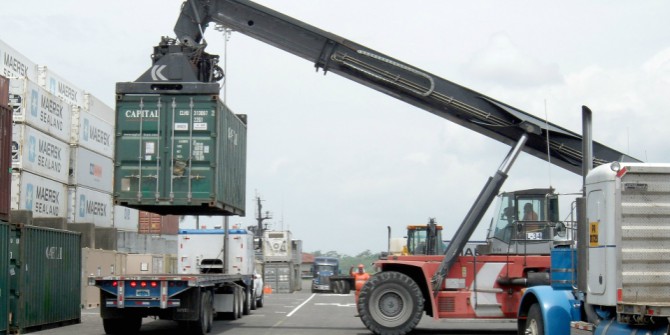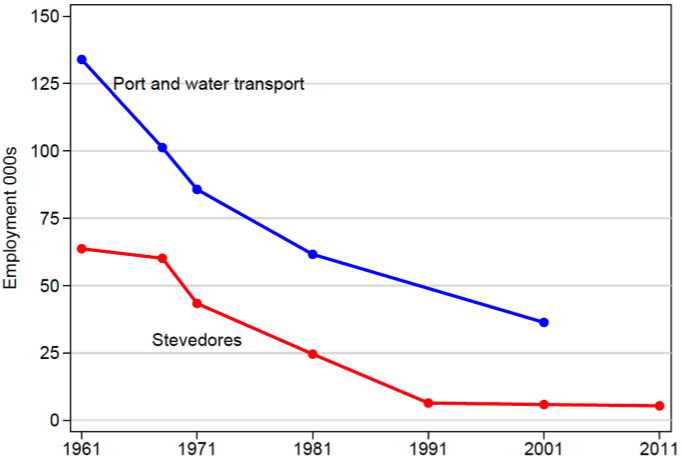
The introduction of containers in UK shipping in the late 1960s suddenly and profoundly changed the labour market for dock workers. Containers require far fewer workers to load and unload cargo, and therefore they greatly reduced the employment of dock-workers (also known as stevedores or longshoremen).
Containerisation had other impacts on UK ports as well. Port activity became much more concentrated in a few locations, rather than being distributed widely around Britain. Containers required deep-water ports and integrated road and rail networks. Many older ports (such as the Port of London) were unsuited to the new technology and declined, while new ports expanded in more suitable locations such as Felixstowe. Figure 1 tracks employment in the port industry and in dock workers’ occupations in Great Britain between 1961 and 2011. Employment in both the industry and the occupation collapsed in the wake of the containerisation of British ports.
Figure 1. Employment in port industries and dock worker occupations 1961-2011 in Great Britain

While this preliminary evidence suggests that this technological change had severe consequences for employment in the industry and for stevedores in particular, it does not tell us what actually happened to the workers involved. Did they find work in other occupations or industries? Did they enter long-term unemployment? Or did the industry simply stop hiring new workers and shrink by a process of attrition? In our recent paper, we investigate how dock workers and workers in port-related industries adjusted to this technological change in both the short and the long run.
District-level evidence
We first identified major ports in England and Wales in 1967 and the local authorities where they were located (Scottish ports were excluded from the study). We then measured employment and unemployment in each local authority district of England and Wales and showed that districts which contained major ports in 1971 did worse than districts which did not contain ports in the years following containerisation.
For example, employment in port districts was higher than non-port districts in 1971, but 20 years later it was significantly lower, and remains lower even 40 years later. Labour markets which contained ports in 1971 fared worse than other labour markets, and this difference has persisted for many years. In addition, both manufacturing and transport employment in port districts shrank relative to non-port districts over this period.
Individual-level evidence
We then considered how individual workers in these districts fared. Perhaps employment fell in port districts because individuals moved to new jobs in other (non-port) areas. To answer this question, we followed a sample of workers from 1971 until 2011 and compared the labour market outcomes of dock workers with similar workers in other occupations and industries. To do this, we matched individuals across carefully defined treatment and control groups according to pre-selected characteristics such as age, marital status, and skill level.
We defined three mutually exclusive treatment and control groups based on occupation (being a stevedore or not), industry (port vs. non-port and non-transport industries), and location (port vs. non-port districts). For example, in order to have a meaningful comparison group for stevedores, one has to choose a pool of workers who are comparable to the stevedores in the nature of their work but who were somewhat insulated from the technological change. After we define the treatment and control groups, we compare employment, unemployment, inactivity and death rates at 10-year intervals. The data comes from The Office for National Statistics (ONS) Longitudinal Study (LS) which follows a sample of approximately 1 per cent of the total population in England and Wales over a period of 40 years (1971-2011).
We find that subsequent differences in labour market outcomes are in fact rather small, insignificantly different from zero and even in some cases positive. Positive differences are most notable in 1981, at which point stevedores were protected from redundancy by the National Dock Labour Scheme (NDLS). For example, we find that stevedores were more likely to be employed in 1981 compared to their matched counterparts. The NDLS was abolished by the Thatcher Tory government in 1989. But even after employment protection was removed, there weren’t large differences in labour market outcomes between dock workers and similar unskilled men who were not dock workers. In fact, we find that stevedores were more likely to keep their occupation in 1991 following the abolishment of the NDLS than workers in the control group.
This result should be interpreted in the light of the unique industrial relations policies which existed for this particular group of workers at the time of the introduction of containers. Dock workers were insulated from redundancy for almost 20 years. This had consequences for the development of new ports in the UK, such that port activity shifted and concentrated in entirely new locations. It should also be recognised that the comparison group (unskilled men who were not dock-workers) experienced very poor labour market outcomes from the 1970s onwards, and so we conclude that rather than doing “well”, dock workers did “no worse” than unskilled men in general.
♣♣♣
Notes:
- This blog post is based on the authors’ paper Off the Waterfront: The Long-Run Impact of Technological Change on Dockworkers, British Journal of Industrial Relations, June 2017
- The post gives the views of its authors, not the position of LSE Business Review or the London School of Economics.
- Featured image credit: Loading, by skeeze, under a CC0 licence
- When you leave a comment, you’re agreeing to our Comment Policy.
 Zouheir El-Sahli is an Assistant Professor in Economics at Leiden University in the Netherlands. Previously, he held research positions at Lund University in Sweden and Aix-Marseille University in France. He holds a PhD in Economics from the University of Nottingham, the United Kingdom.
Zouheir El-Sahli is an Assistant Professor in Economics at Leiden University in the Netherlands. Previously, he held research positions at Lund University in Sweden and Aix-Marseille University in France. He holds a PhD in Economics from the University of Nottingham, the United Kingdom.
 Richard Upward is a Professor of Labour Economics at the University of Nottingham and a research Fellow of the Nottingham Centre for Globalisation and Economic Policy (GEP) He completed his PhD at the University of Manchester and has held research positions at the Universities of Bristol, Manchester and Nottingham.
Richard Upward is a Professor of Labour Economics at the University of Nottingham and a research Fellow of the Nottingham Centre for Globalisation and Economic Policy (GEP) He completed his PhD at the University of Manchester and has held research positions at the Universities of Bristol, Manchester and Nottingham.






There are a few areas here that would benefit from further clarification. For example, the assertion that “dock workers were insulated from redundancy for almost 20 years” is misleading. Yes, dockers were protected from compulsory redundancy as part of the 1972 A-J agreement, but the industry instead shed labour through voluntary redundancy. In fact, in the 20 years that you highlight, the number of RDWs (Registered Dock Workers) fell from 60,000 to less than 10,000 (NAPE, 1988), hardly the hallmark of ‘insulation’ from redundancy. It would be helpful to make this distinction.
You also use the terms ‘stevedore’ and ‘docker’ interchangeably – these were two different grades of worker on the docks, particularly prior to container hegemony. This also hints at issues surrounding defining dock work as unskilled and as comparable to unskilled work in other sectors.
Dockers unloaded, stevedores packed, the latter coming from the Spanish, “estibador”. Much easier taking the goods off than putting them on.
Ports such as Felixstowe and Shoreham became important because they were never in the Scheme. Felixstowe was unsuitably placed, compared to Harwich, as a look at the map shows, but but was not subject to crippling labour restrictions. It had previously been too unimportant to include in the Scheme. Dover likewise, which had been a special case as a passenger port only, until the Western Docks grew.